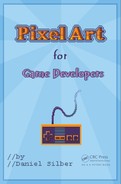CHAPTER 7
Drawing Secrets Revealed
It’s All Smoke and Mirrors
T
may seem like magic—and when
an artist makes something appear it can certainly feel like sorcery. Of
courseart isnotmagic but followsaseries ofrulesthatcanbetaught—much
like the principles that govern programming.
Some of the specic rules that make artwork look convincing are shad-
ing and cast shadow, light consistency, atmospheric perspective, and linear
perspective.
Note to artists: If you are already pretty condent in your art abilities, you
are likely to have been exposed to most of the material in this chapter... So I
won’t be heartbroken if you skip ahead (feckless hooligan). That being said,
if you want a refresher or simply enjoy my witty banter—read on!
7.1 SHADING
If you’ve worked in D you may be familiar with the idea of raycasting or
normals (although don’t freak out if you haven’t, I’m trying to connect with
my programmer brethren); drawing with shadow is done the same way.
Basically it works like this: Any surface that is perpendicular to a light
source reect back the most light and be the brightest part of an object.
As the surface angles becomes closer to 180
○
(being parallel to the light
source), the surface will appear darker. Let’s look at Figure.—notice how
the plane most closely facing the light source (the top) is lighter and the
side facing away from the light source is the darkest.
71
72 Pixel Art for Game Developers
We can see in Figures . through . how changing the relationship of
the light source changes the angle that the light hits each surface of the
cube. Note how in each case, the surface that most faces the light source is
the lightest.
FIGURE 7.1 Surfaces facing the light source will appear lighter.
FIGURE 7.2 Light sources don’t
always come from above.
FIGURE 7.3 The angled surfaces
reect diering amounts of light.
Drawing Secrets Revealed 73
This is the major concept that underlies creating the illusion of D form
in two dimensions. There are other ideas that get used in conjunction but
this is the big momma of concepts for drawing form.
For curved forms, the angle of the surface changes in relation to the light
source so we use a gradient to represent this, as shown in Figure ..
That wasn’t too bad, was it?
FIGURE 7.4 Curved surfaces
gradually change angle.
FIGURE 7.5 Light can bounce o
other surfaces.
Since we’ve started looking at the lighting of a sphere, I’m just going to
give a couple more concepts. Two lighting eects that will oen occur on a
sphere is a highlight (sometimes called a specular highlight or “spec hit” in
game development) and reected or “bounced” light.
Reected light is seen when an object gets light from a source other than
the primary light source. In the case of Figure ., thereis light bouncing o
thegroundthatmakesabandatthebottomofthesphereabitlighter.
Ahighlightiswherethisisa highconcentrationof brightareathatreects
o of an object, also seen in Figure ..
Onelastideaforyoutochewonisthatalloftheseexamplesarebuilt
in a neutral gray without much notable texture. In general, objects have
various dierent attributes that aect the way that light bounces o them.
Consider how much highlight you would observe on a freshly waxed wood
oor compared to a rug. Obviously a wood oor would give a much more
acute highlight, and perhaps even a bit of reection. Don’t get bent out of
shape with the potential complexity—just be aware that these things exist.
74 Pixel Art for Game Developers
7.2 CAST SHADOW
So keeping the concept of rays of light in mind—if one object is reecting
the ray of light, then those rays will not hit any objects behind. In the case
of our cube, we can imagine the rays of light continuing the path to map out
where the cast shadow will fall, as done in Figures. through ..
FIGURE 7.6 The edges of the object
block light.
FIGURE 7.7 Onewaytogurethe
shape of a cast shadow.
FIGURE 7.8 Cast shadow.
Since the object is bouncing those rays of light, they never reach the
surfacebelowandthatareawillbeinshadow.Forthisreason,itisalways
supremely important to know where the scene’s light source is—at least if
youwanttocreateacceptableshadows.
Drawing Secrets Revealed 75
The images with the cube in Figures . through . show the step-by-
step process of how to gure out where the object’s shadow will fall on the
ground.InFigure.,wecannotehowandwheretheedgesofthecubewill
cast shadow on the ground, and in Figure ., we see the nal outcome of
our eorts.
FIGURE 7.9 Edges that cast the
shadow.
FIGURE 7.10 Acubewithshadow.
The idea is straightforward but it can get complicated when dealing with
unusual surfaces. Fortunately for us, in most cases we can approximate and
the viewer’s eye will accept it within the context of the picture.
One last concept in regard to cast shadow is that in real life shadow is
notcastuniformly.Theshadowisusuallydarkestclosetowheretheobject
touches the surface and gets lighter as itgetsfatheraway.Thisisillustrated
in Figure .. Also of note is that the edges of a shadow tend to get blurrier
as they are farther from the casting object.
FIGURE 7.11 Shadows tend to get blurrier further away.
..................Content has been hidden....................
You can't read the all page of ebook, please click here login for view all page.
